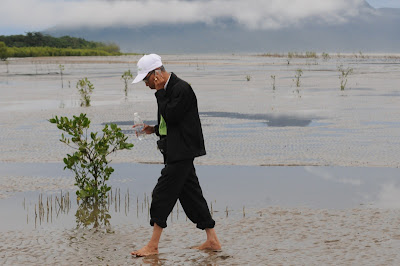World Wetlands Day is celebrated on February 2 every year. The Kuching Branch of the Malaysian Nature Society recognised the 2012 event by organising a special event, 10 days later on February 12, at Kampung Bako, with the support of local villagers.
Bako is a gateway both to the national park that shares its name and to Bako-Buntal Bay, an important staging post and wintering ground for water birds and a designated Important Bird Area (IBA).
The trip served a double purpose: to educate the villagers, and especially their children, to the importance of the area, and to visit the sandflats in the bay. I was, of course, delighted to be invited to come along.
On the way, we could see that some reclamation was going on in the mangroves: note that the trees in the foreground are arranged in neat, and obviously planted, rows.
Our team included the village headman (Tuan Haji Wahid bin Sani), several honorary kampung wardens, and crack birders like Daniel Kong (second from left, with binoculars).
On the way, we could see that some reclamation was going on in the mangroves: note that the trees in the foreground are arranged in neat, and obviously planted, rows.
Our team included the village headman (Tuan Haji Wahid bin Sani), several honorary kampung wardens, and crack birders like Daniel Kong (second from left, with binoculars).
To get very far in an exploration of the sandflats, even at low tide, you definitely need a boat (or, in our case, a couple of boats). For other photos of the event see the MNS Kuching blog entry here.
Daniel photographs me. I return the compliment.
Daniel photographs me. I return the compliment.
Yeo Siew Teck checks the sandflats for birds.
The village headman takes a phone call as he explores the bay.
The wardens seemed to enjoy the experience immensely!
Most of the birds we saw were, unfortunately, at a fair distance, but we had several scopes with us to make up for that.
These Terek Sandpipers (Xenus cinereus), a common wintering species on the bay, did venture a bit closer.
Certainly the bird of greatest importance for the bay's status as a conservation area is the Chinese Egret (Egretta eulophotes).Though classed as Vulnerable, not Endangered, by Birdlife International, this is a declining species with a total estimated population of only 2,600-3,400 mature individuals (even if, as Birdlife suggests in its fact sheet on the species, this is an underestimate, the population is still very low).
More than 400 Chinese Egrets have been recorded wintering at Bako-Buntal Bay – perhaps at 10 of the entire global population.
Besides scanning the distance for birds, I kept my eye out for things close at hand. This cast-up, bleached cowrie shell (Cypraea sp.) bears the lower valves of a number of jingle shells (Anomiidae) that glued themselves to it in life.
This shell of this Girdled Horn Snail (Cerithidea cingulata), a common mudflat inhabitant, has been taken over by a banded hermit crab (species uncertain).
Where there is mud (at least in Southeast Asia) there are sure, at least where the water is brackish or salt, to be mudskippers. This little fellow leaping out of the water is probably a Serpent Mudskipper (Parapocryptes serperaster).
These may be too (they seem particularly long-bodied), though they are so covered with mud that I cannot make out their identifying features.
Yeap Chin Aik, head of conservation for MNS, gave a presentation on the importance of Bako-Buntal Bay to the East Asian-Australasian Flyway, the major migratory route for the winter.
The presentation was followed by awards to the local children, who had been busy at a colouring contest while we were out on the bay.
As we were getting ready to head for home, I found more mudskippers along the shores of the inlet.
Male Blue-spotted Mudskippers (Boleophthalmus boddarti) raised their ornate dorsal fins in challenge to their rivals.
For such seemingly-drab and often mud-covered little fishes, Blue-spotted Mudskippers are surprisingly well-ornamented.
So is their cousin, the Gold-spotted Mudskipper (Periophthalmus chrysospilos). Birds may well have been the reason for our morning on the bay, but mudskippers made for a charming end to it.















.JPG)
.JPG)
.JPG)
.JPG)


.JPG)








.JPG)
.JPG)
.JPG)
.JPG)
.JPG)
.JPG)
No comments:
Post a Comment